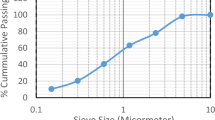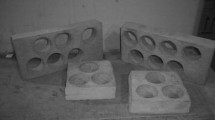Abstract
This paper deals with an experimental study on flexural bond strength of masonry using various blocks in combination with different mortars. Flexural bond strength of masonry has been determined by testing stack-bonded prisms using a modified bond wrench test set-up. The effect of mortar composition and strength on the masonry's flexural bond strength using three types of masonry units (stabilized mud blocks, stabilized soil-sand blocks and burnt brick) has been examined. The effect of the masonry unit's moisture content on flexural bond strength has also been studied. Increases in mortar strength lead to increased flexural bond strength for cement mortar, irrespective of the type of masonry unit. It has been found that combination mortars, such as soil-cement mortar and cement-lime mortar, lead to better bond strength compared to cement mortars. The moisture content of the masonry unit at the time of casting has displayed significant influence on the flexural bond strength of the masonry. It has been found that for each type of masonry unit, an optimum moisture content exists, beyond which the flexural bond strength falls off quickly.
Résumé
On présente ici une étude expérimentale de l'adhérence en flexion de maçonneries composées de blocs différents confectionnés à partir de divers mortiers. On a déterminé l'adhérence sur des prismes essayés avec un dispositif en flexion modifié. On a examiné l'effet de la composition du mortier et de la résistance sur l'adhérence en flexion de la maçonnerie en utilisant trois types d'unités (blocs de boue stabilisée, de terre/sable stabilisés et de brique). On a aussi étudié l'influence de la teneur en humidité de la maçonnerie sur l'adhérence. Pour le mortier de ciment, quel que soit le type d'unité, l'accroissement de la résistance du mortier entraîne une amélioration de l'adhérence avec les mortiers combinés (terre/ciment et ciment/chaux). La teneur en humidité de l'unité de maçonnerie au moment du coulage a une influence significative sur l'adhérence en flexion. Pour chaque type de maçonnerie, il existe une teneur optimale au-delà de laquelle l'adhérence en flexion diminue rapidement.
Similar content being viewed by others
References
Venkatarama Reddy, B.V., ‘Studies on static soil compaction and compacted soil-cement blocks for walls’, Ph.D. thesis (Dept. of Civil Engineering, Indian Institute of Science, Bangalore, India, April 1991).
IS: 3495, ‘Indian standard code of practice for methods of tests for burnt clay building bricks’ (Bureau of Indian Standards, 1976).
AS CA47, ‘Australian code of masonry’, Australia, 1969.
BS 5628, ‘Code of practice for structural use of masonry, Part 1. Unreinforced masonry’ (British Standards Institution, 1978).
ASTM E518, ‘Standard test methods for flexural bond strength of masonry’ (American Society of Testing and Materials, 1980).
ASTM C1072, ‘Standard method for measurement of masonry flexural bond strength’ (American Society of Testing and Materials, 1986).
Venu Madhava Rao, K., ‘Some studies on flexural and compressive strength of masonry’, M. Sc (Engg.) thesis (Dept. of Civil Engineering, Indian Institute of Science, Bangalore, India, 1993).
Sinha, B.P., ‘Model studies related to load bearing brick work’, PhD Thesis (University of Edinburgh, 1967).
Author information
Authors and Affiliations
Rights and permissions
About this article
Cite this article
Venu Madhava Rao, K., Venkatarama Reddy, B.V. & Jagadish, K.S. Flexural bond strength of masonry using various blocks and mortars. Mat. Struct. 29, 119–124 (1996). https://doi.org/10.1007/BF02486202
Published:
Issue Date:
DOI: https://doi.org/10.1007/BF02486202




